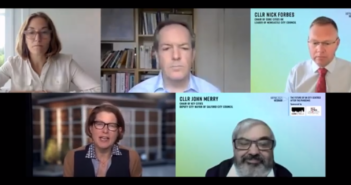Writing New Urban Rules kicked off MIPIM Day 1 with a powerful call to action for global cities: adapt today or be conquered by tomorrow’s challenges. By 2050 over 66% of the world’s population will live in cities and real estate development controls whether this growth is beneficial for or to the detriment of city dwellers and that of the environment. Although the six panellists come from completely different cultural and occupational backgrounds, each agreed that cities can cure themselves of the self-inflicted diseases of social inequality, congestion, crime and high levels of emissions created by the building industry. They also agreed for the need to create a social and environmental sustainable home for citizens. How can this be achieved? Through the complete collaboration of private and public sectors.
James Alexander, Director of C40 Cities Climate Leadership Group, cleverly pointed out that politicians don’t build cities, real estate developers do. He continued to compare cities to that of a living organism, which only functions and thrives if the parts are synchronized in function. Politicians, real estate developers and city planners are the drivers behind the city as a life form and they must keep in mind that the main stakeholders are the residents of the city.
The undeniable need for affordable housing and pristine public spaces was repeatedly mentioned and acutely emphasized during Dr. Auma Obama’s testimony of the current state of many cities across Africa. She mentioned that much of the pollution, crime and congestion that is rampant in many African cities are symptoms of the people’s feeling of lack of ownership. Meaning that if all citizens could “own” the development concepts within the city, they would naturally take greater care of public spaces. However given the current situation it’s is difficult to ask slum dwellers to take care of public spaces and participate in sustainable activities when they have had no say regarding the conditions in which they live. Dr. Obama continued in saying that the first step in creating humanely inclusive cities of tomorrow is by eradicating slums and offering a dignified life to everyone. She urged that cities must place social profit in balance with economic if they are to overcome the current inequality that exists.
Switching gears, Amanda Clack, Executive Director at CBRE, referenced the tremendous growth occurring in China and cities such as Shanghai. Shanghai and many other cities will eventually grow to the scale to have the same economic and social influences as many countries across the world. The implications of this are far reaching and it’s incumbent upon city planners to ensure that homes, transportation and jobs are obtainable for everyone. In the age where technology is king and queen, utilizing big-data analytics will be critical in providing decisions makers with the ability to improve the living conditions of citizens. However, Jean-Louis Missika, Parisian Deputy of Urban Planning, sited that technology could add to the tribulations of cities if not carefully managed. Autonmous vehicles, for example, could create a situation where citizens are comfortable with longer commuting times and live on the outskirts of cities. This effectively would create less density and negatively add to current carbon emissions.
Missika is optimistic in light of cross-national agreements such as the Paris Climate Accord. As climate change awareness becomes more mainstream we should expect to see further development of policies. It is important to remember, however, that cities make sacrifices to meet these targets, not nations. Only through the partnership of industry and cities can climate goals be realistically achieved.
James Alexander redirected and reemphasized that the lack of social and environmental sustainability are the biggest challenges facing cities today. He painted a picture where such a large wealth disparity is blatantly seen when a 5-star hotel can exist directly next to an extremely impoverished slum. James went on to state that this situation “is not sustainable”. A mild point of contention arose when Dr. Obama disagreed by saying current social inequality is sustainable because social inequality has always existed unfettered for all of human existence. Debra Mountford of the OECD added that society knows how to solve the social inequity that exists across the globe however we have not solved these issues because public and private interests are not aligned and if ignored for too long there will be a tipping point.
Chris Marlin, President of Lennar International, stressed that the tremendous pace of technological development is generating significant stress on city governments and that a much better job can be done in the USA. To make matters worse, government bureaucracy often creates a situation where the speed of much needed real estate development is dampened because entitlements, zoning and other approvals are unnecessarily delayed. Chris mentioned the one belt, one road project that China has enacted as a model project that showcases the possibilities that can be achieved if the public and private sectors partner together.
The potential for widespread public and private collaboration in conjunction with technological advancements provides a unique opportunity to create sustainable conditions for cities and, most importantly, all their occupants.



